1. How do I search the Online Catalog?
The easiest way to search the catalog is to enter a simple search term or phrase in the search box
on the main catalog search page.
Examples of search terms and phrases are shown in the search box. (See Example 1-1)
 Example 1-1
Example 1-1
You can perform more complex searches by selecting "Advanced Search" or "Search Archival Records"
from the main search page, or by selecting "Advanced Search" from any other
catalog screen. (See Example 1-2) This will bring you to a screen on which you can enter multiple
search terms to broaden or narrow your search. (See Example 1-3) This screen also offers search
tips and descriptions of the types of searches available. Examples of each type
of search are shown under the typing area for each search type.
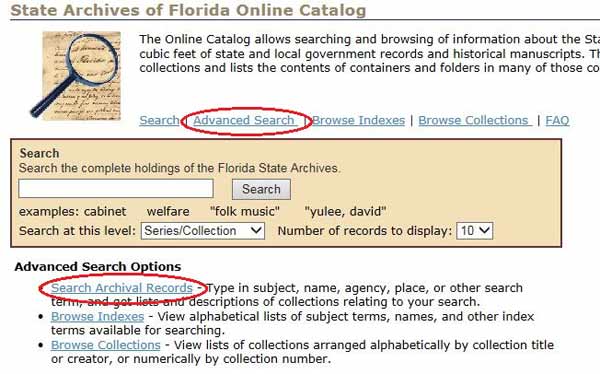 Example 1-2
Example 1-2
 Example 1-3
Example 1-3
2. What is meant by browsing indexes and browsing collections?
Browsing Indexes: Indexes are alphabetical lists of names and subject terms
included in catalog records to facilitate searching for collections. For instance,
the subject index term "Education and state" would probably be included in the
catalog record for a collection having information about education policy. Browsing
indexes allows you to look through these alphabetical lists of names and subject
terms and, by clicking on any of the terms on the list, to automatically search
the catalog for materials matching that term. (See Examples 2-1, 2-2)
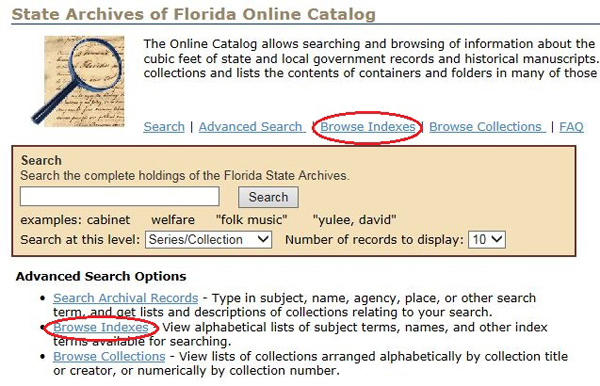 Example 2-1
Example 2-1
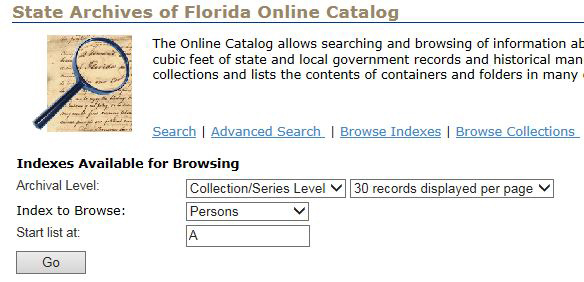 Example 2-2
Example 2-2
Browsing Collections : Browsing collections is more like browsing the shelves
of a library, where you can see the author and title and call number for each
item/collection and can select one to look at more closely. (See Examples 2-3, 2-4)
 Example 2-3
Example 2-3
 Example 2-4
Example 2-4
3. What kinds of information will I find in the online catalog?
The online catalog provides information about the origins, arrangement, subject content, and physical
characteristics of collections included in the Florida State Archives' holdings
of over 40,000 cubic feet of state and local government records and historical
manuscripts collections. The catalog provides descriptions of over 2,800 collections
and lists the contents of containers and folders in many of those collections.
4. Are all of the Archives' holdings described in the catalog?
Yes, but descriptions for fully-processed collections will be more detailed than those for collections
not yet fully processed. Most descriptions of the Archives' holdings include
lists of container titles and often folder titles as well.
Because each collection can contain many thousands of individual documents or other items, archives
rarely list or catalog the individual items contained in the collections. However,
a small number of the State Archives' most significant and heavily-used collections
can be searched at the item level elsewhere on the State Archives web site.
For instance:
Over 91,000 photographic images of Florida people, places, and events are available for searching and
viewing on the Florida State Archives' Florida Photographic Collection page
at http://www.floridamemory.com/PhotographicCollection.
Over 13,000 complete files comprising the Florida Confederate Pension Application Files have been
scanned and are available for viewing at http://www.floridamemory.com/Collections/PensionFiles.
Over 6 cubic feet of historical manuscripts comprising the Call Family and Brevard Family Papers
have been scanned in their entirety and are available for viewing at http://www.floridamemory.com/Collections/CallBrevardPapers.
The papers include correspondence, writings, and other papers of Richard
Keith Call, territorial governor of Florida, and his family. The collection
offers highly significant and unique documentation of Florida's territorial,
early statehood, and Civil War history; the development of early Tallahassee;
issues and attitudes concerning slavery and race, and Union and secession; and
the effects of the Civil War on the lives of planters of the Old South. Particularly
significant among the Call papers is correspondence between Richard Keith Call
and Andrew Jackson.
5. What is meant by the "level" of search?
Archival collections exist in groupings and subgroupings of materials. The usual grouping levels
of archival collections are:
- record group
- series
- container (often a box)
- folder (or other filing unit)
- item
The largest grouping, the "record group," refers to all the records created by a particular department
or organization. For instance, all records from the Department of Transportation
together form the Department of Transportation record group.
Record groups are comprised of multiple subgroupings known as "series." A series is a set
of records that documents a particular function, activity, or program of an
agency, office, or organization. For instance, within the Department of Transportation
record group, there might be a series of "highway planning maps," and another
series of "road surface research files," and another series of "transportation
legislation development and tracking files," etc.
Within each series are smaller groupings of records. Each series usually consists of one or more
containers; each container usually consists of one or more folders; and each
folder usually contains one or more documents or other items.
The online catalog is capable of searching for descriptions of record groups, series (or "collections"
for manuscript materials), and boxes/folders/items. We recommend that you begin
any research project by searching at the series/collection level (the default
setting). This will give you the best sense of the most significant available
resources relating to your research project.
6. What information will I get when I enter my search?
When you submit your search, you will get a screen which will indicate at the top how many records
matched your search, followed by a numbered list of matching records. For instance,
if you perform a search at the series level, you will get a numbered list of
relevant series or collections providing the following for each:
- record group identification number
- series identification number (similar to a call number for a library book)
- creator of the series or collection
- title and dates of the collection
- quantity of materials comprising the collection
7. Can I get additional information on a record in the result list?
Yes. You can get more descriptive information about any record in a numbered result list by clicking
on the result number. (See Example 7-1) This will give you a "Details Page" which, for a series/collection
result, will give you the record group and series identification numbers (similar
to a call number for a library book), historical or biographical background
information about the agency, organization, person, or family that created the
collection, a narrative description of record type(s) founds in the collection
and the subject content of the records, information about any restrictions on
access to or use of the materials, and any other available information to facilitate
understanding and use of the collection. (See Example 7-2)
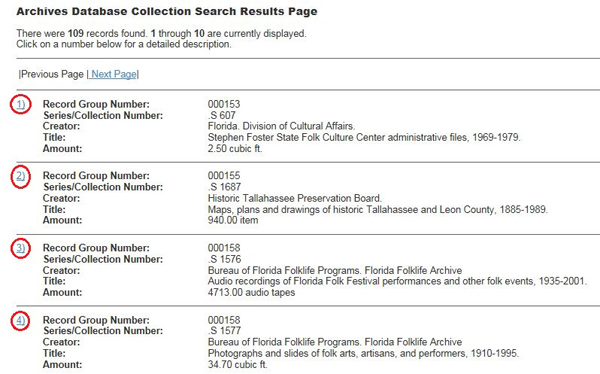 Example 7-1
Example 7-1
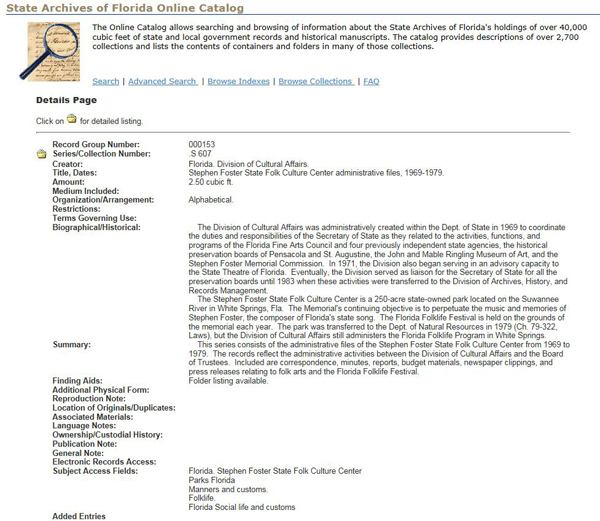 Example 7-2
Example 7-2
8. Is there more specific information available about the contents of a series or collection?
Yes. Most descriptions of the Archives' holdings include lists of container titles and often folder
titles as well. To see any available container or folder listing for a particular
series or collection, click on the folder icon to the left of the "Series/Collection
Number:" label. (See Example 8-1) This will bring give you a "Detailed Listing" screen providing
a list of the containers comprising that series or collection, and sometimes
listing the folders within those containers.
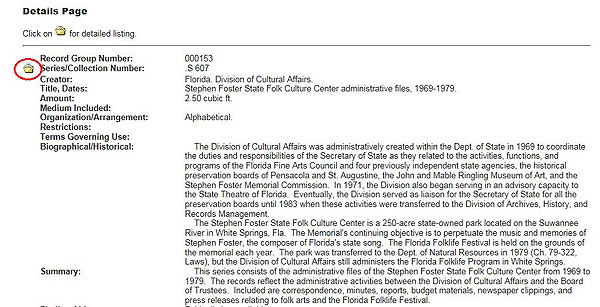 Example 8-1
Example 8-1
The first entry on the "Detailed Listing" screen is the record group title. The second entry
is the title of the series or collection. The following entries are the container
and folder titles. By clicking on any entry on a "Detailed Listing" screen,
you can see the catalog record for that entry. (See Example 8-2)
 Example 8-2
Example 8-2
9. What do all those numbers in brackets mean in the Detailed Listing?
The first entry on the "Detailed Listing" screen is a 6-digit record group number, such as [000450],
followed by the record group title. (See Example 9-1)
 Example 9-1
Example 9-1
The second entry is the series/collection number (with the record group number as a prefix),
such as [000450/.S 164], followed by the series/collection title.
The next entry is the five-digit container number of the first container (with the record group
number and series/collection number as prefix), such as [000450/.S 164-00001],
followed by the title of that container
If folders are listed for the container, each folder title is preceded by a five-digit folder
number (with the record group, series/collection, and container numbers as prefix).
For example, [000450/.S 164-00001.00014] means Record Group 450, Series S 164, container 1, folder 14.
This numbering scheme [Record Group /Collection.Series -Container.File Unit #Item] follows
throughout each “Detailed Listing” screen.
10. Can I request materials that I find in the online catalog?
You can let Archives staff know of your interest in using materials you find in the online catalog
by sending an e-mail to archives@dos.myflorida.com,
or by calling our reference staff at 850-245-6700. Include in your request
the series/collection number and title, and the box and folder numbers if appropriate.
This will allow our reference staff to confirm the availability of the materials
you wish to use and to let you know of any restrictions or other conditions
of use of the materials. Because the Archives' collections are unique and irreplaceable,
they can only be used on-site at the State Archives research facility in Tallahassee.
Registered Archives researchers can create and print pull slips by clicking on any container, folder,
or item entry listed on a "Detailed Listing" screen (see #8 and 9 above for
information about the "Detailed Listing" screen), entering your 7-digit patron
number (use as many leading 0s as necessary) into the "Enter Patron ID:" box,
and clicking on the "Create Pull Slip" button. (See Example 10-1) You can then bring the pull slip
to the Archives and provide it to our reference staff, who will be able to retrieve
the records quickly using the information on the pull slip.
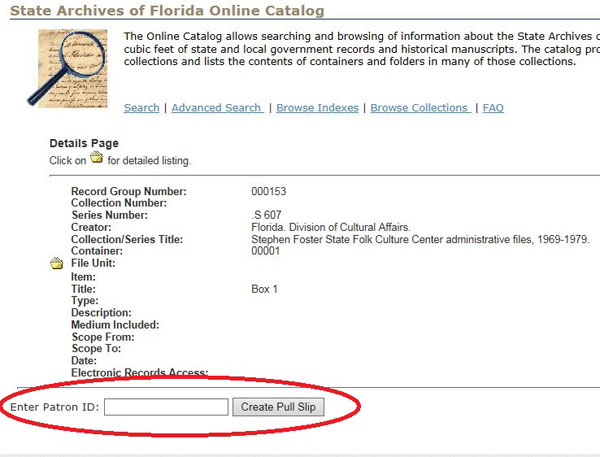 Example 10-1
Example 10-1
11. How was the catalog designed/built?
The Florida State Archives uses a software package called Re:discovery, designed and customized
by Re:discovery Software, Inc. (RSI; see http://www.rediscov.com/
), to perform archival collections management and cataloging functions.
RSI's web interface allows search and display on the World Wide Web of descriptive
cataloging information from the Re:discovery database. The screen appearance
of the Florida State Archives web interface is based on requirements provided
to RSI by the Florida State Archives, with some minor modifications made by
Archives staff.













